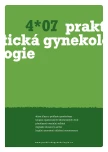The thyroid from the gynecologist's point of view.
Authors:
M. Borovský; M. Lattáková
Authors‘ workplace:
I. gynekologicko–pôrodnícka klinika LF UK a FNsP Bratislava
Published in:
Prakt Gyn 2007; 11(4): 161-163
Overview
Subclinical hypothyroidism is characterised by increased level of TSH (thyroid stimulating hormone) with normal concentrations of free thyroxine. Its incidence ranges from 4 to 10 % and is more frequent in women than in men. It can cause menstrual cycle disorders, infertility, premature birth, as well as impaired psychomotor evolution of the child. In spite of that, the question of whether or not to treat subclinical hypothyroidism is still controversial. Treatment should be considered if there are thyroidal antibodies indicating increased risk of progression of hypothyroidism, the presence of hypothyroidism and of menstrual disorders, and in pregnancy planning.
Key words:
subclinical hypothyroidism – infertility – thyroidal antibodies
Sources
1. Fenichel R, Davies TF. When should you screen for and treat mild hypothyroidism? Contemp Ob Gyn Jan 2006. www.modernmedicine.com/modernmedicine/ article/articleDetail.jsp?i d=283482
2. Hollowell JG, Staehling NW, Flanders WD et al. Serum TSH, T4 and thyroid antibodies in the United States population (1988 to 1994): NHANNES III. J Clin Endocrinol Metab 2002; 87: 489–499.
3. Baloch Z, Carayon P, Conte-Devolx B et al. Laboratory medicine practice guidelines. Laboratory support for the diagnosis and monitoring of thyroid disease. Thyroid 2003; 13: 3–126.
4. Canaris GJ, Manowitz NR, Mayor G et al. The Colorado thyroid disease prevalence study. Arch Intern Med 2000; 160: 526–534.
5. Ladenson PW, Singer PA, Ain KB. Americam thyroid association guidelines for detection of thyroid dysfunction. Arch Intern Med 2000; 160: 1573–1575.
6. Vanderpump MP, Tunbridge VM, French JM et al. The incidence of thyroid disorders in the community: a twenty-year follow up of the Whickham Survey. Clin Endocrinol (Oxf) 1995; 43: 55–68.
7. Poppe K, Velkeniers B. Female infertility and the thyroid. Best Pract Res Clin Endocrinol Metab 2004; 18: 153–165.
8. Haddow JE, Palomaki GE, Allan WC et al. Maternal thyroid deficiency during pregnancy and subsequent neuropsychological developement of the child. N Engl J Med 1999; 341: 549–555.
9. Casay BM, Dashe JS, Wells CE et al. Subclinical hypothyroidism and pregnancy outcomes. Obstet Gynecol 2005; 105: 239–245.
10. Premawardhana LD, Parkes AB, Ammari F et al. Postpartum thyroiditis and long-term thyroid status: prognostic influence of thyroid peroxidase antibodies and ultrasound echogenicity. J Clin Endicrinol Metab 2000; 85: 71–75.
11. Monzani F, Caraccio N, Kozakowa M et al. Effect of levothyroxine replacement on lipid profile and intima-media thichness in subclinical hypothyroidism: a double-blind, placebo controlled study. J Clin Endocrinol Metab 2004; 89: 2099–2106.
12. Hak AE, Pols HA, Visser TJ et al. Subclinical hypothyroidism in an indipendent risk factor for atherosclerosis and myocardial infarction in erderly women: the Rotterdam Study. Ann Interrn Med 2000; 132: 270–278.
13. Parle JV, Franklyn JA, Cross KW et al. Thyroxine prescription in the community: serum thyroid stimulating hormone level assay as an indicator of undertreatment or overtreatment. Br J Gen Pract 1993; 43: 107–109.
Labels
Paediatric gynaecology Gynaecology and obstetrics Reproduction medicineArticle was published in
Practical Gynecology

2007 Issue 4
Most read in this issue
- Premature ovarian failure – POF
- Legal anonymous possibilites of casting aside a new-born – current practice in Czech Republic
- Differential diagnostic and therapy of recurrent pregnancy loss
- In vitro maturation of oocytes – our experiencies in prevention of ovarian hyperstimulation syndromein patients at risk of OHSS
